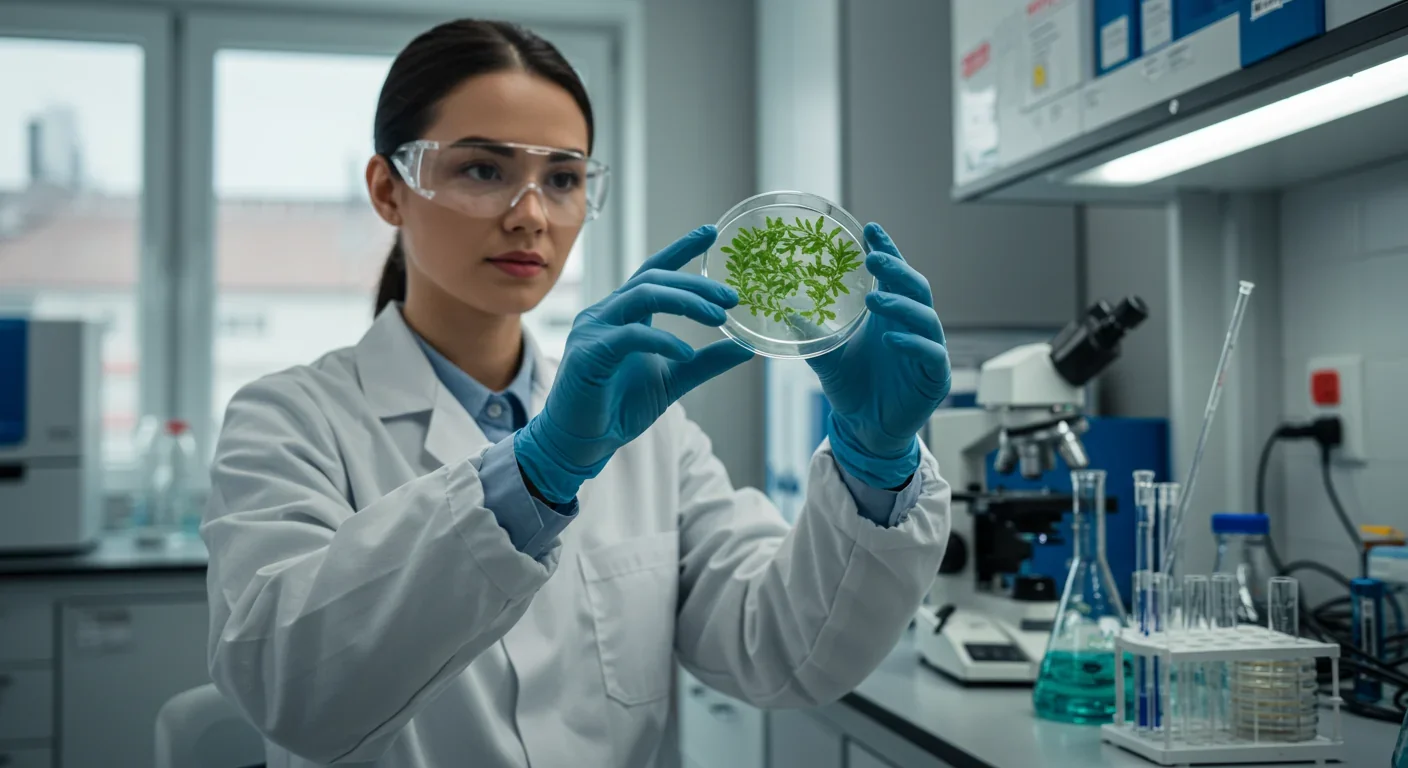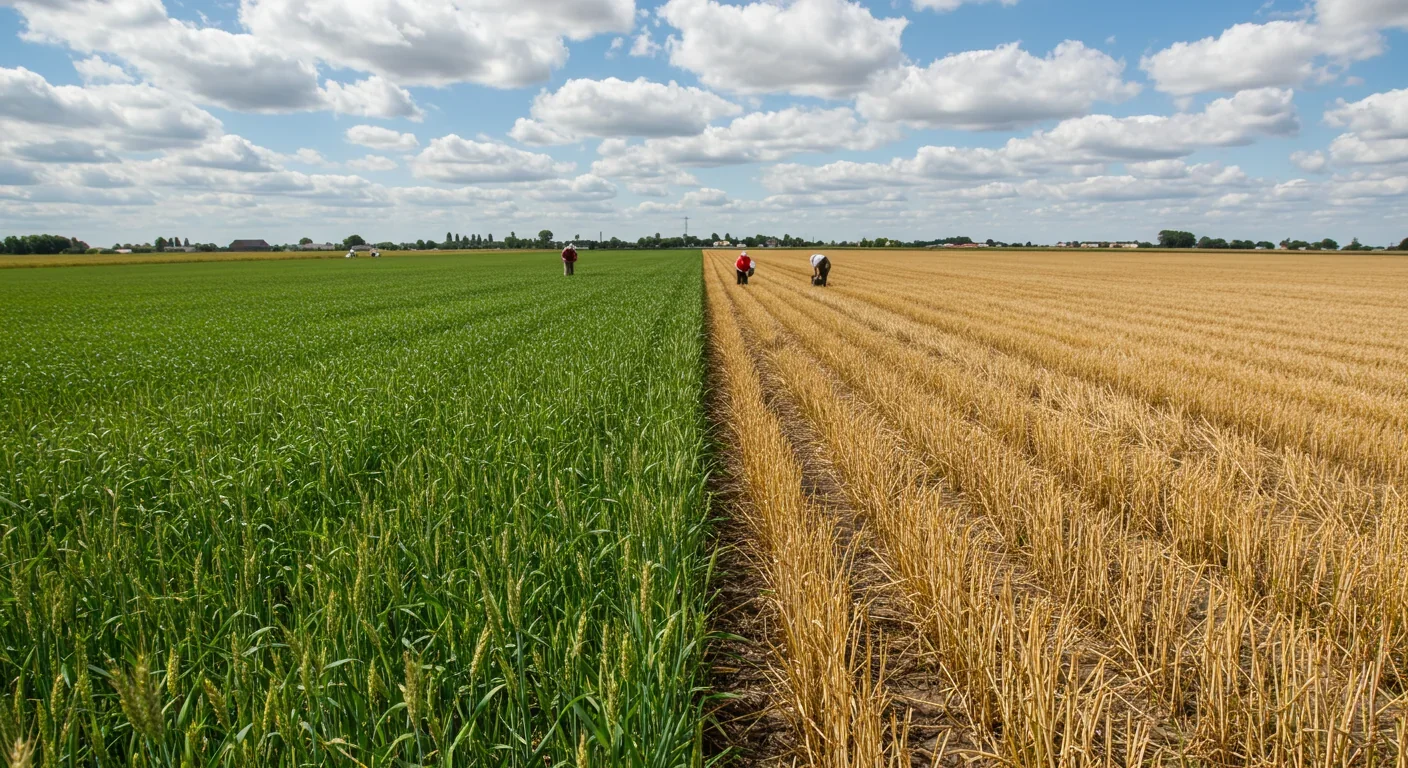Forest Biological Clocks: Ecosystems That Keep Time

TL;DR: Resurrection plants survive losing 99% of their water through molecular strategies involving protective proteins, sugar shields, and antioxidants. Scientists are racing to transfer these traits into crops to combat climate-driven droughts threatening global food security.

Picture a plant so shriveled it looks dead, crumbled into a tight brown ball. You could mistake it for kindling. But add water, and within hours it unfurls into vibrant green life—like watching evolution run in reverse. These aren't science fiction creations or genetic experiments gone rogue. They're resurrection plants, and they've mastered a survival trick that could reshape how humanity feeds itself in a warming world. By 2050, scientists predict droughts will threaten food security for billions. What these ancient organisms know about surviving the impossible might be exactly what we need to learn.
Resurrection plants don't just tolerate dry conditions—they embrace total dehydration. While most plants die when they lose 50-60% of their water, species like Selaginella lepidophylla (the Rose of Jericho) and Craterostigma plantagineum routinely survive losing 95-99% of their cellular water and spring back to life within hours of rainfall. It's a feat so remarkable that researchers call them "vegetative zombies."
The mechanism isn't magic—it's meticulous biological engineering. These plants don't avoid dehydration; they engineer controlled shutdowns that preserve their cellular machinery through years of drought. When water returns, they reboot their systems with astonishing speed. Selaginella lepidophylla unfurls its fronds within 3-4 hours of rehydration, a recovery so rapid it seems staged.
What makes this possible? A cocktail of protective strategies that scientists are only beginning to decode. The real breakthrough isn't that these plants survive—it's how they do it without the cellular carnage that kills everything else.
Inside a desiccating resurrection plant, chaos should reign. As water exits cells, membranes should collapse, proteins should denature, DNA should fragment, and metabolism should grind to a catastrophic halt. Instead, these plants deploy molecular bodyguards.
Late Embryogenesis Abundant (LEA) proteins act like cellular bubble wrap. As cells shrink, LEA proteins stabilize membranes and protect other proteins from damage, essentially creating a protective scaffold that maintains structure even when there's almost no water left. Think of them as airbags for cellular components—inactive during normal conditions but instantly protective when impact happens.
Then there's trehalose, what researchers call "the sugar of life." This disaccharide isn't just food storage; it's a glass-forming molecule that replaces water in cellular spaces. When resurrection plants dehydrate, trehalose concentrations skyrocket, forming a glassy matrix that immobilizes proteins and membranes in stable configurations. It's vitrification—the same process used to preserve human organs for transplant, but evolved naturally millions of years ago.
Reactive oxygen species (ROS) pose another threat. When metabolism restarts after rehydration, oxygen radicals flood cells, causing oxidative damage that can kill. Resurrection plants counter this with supercharged antioxidant systems—enzymes like superoxide dismutase and catalase—that neutralize ROS before they wreak havoc. It's damage control on a molecular scale.
Resurrection plants aren't evolutionary newcomers. The genus Selaginella dates back over 400 million years to the Devonian period, making these plants older than dinosaurs. They've refined their desiccation toolkit across epochs of climate change, surviving mass extinctions and continental shifts.
Today, they inhabit some of Earth's harshest environments. Myrothamnus flabellifolius thrives in the rocky outcrops of southern Africa, where rainfall is sporadic and soils are skeletal. Craterostigma plantagineum populates the seasonally arid regions of Namibia and South Africa, enduring months-long droughts followed by brief wet seasons. These aren't marginal habitats—they're laboratories of extremophile evolution.
Each species has tweaked the basic resurrection playbook slightly differently. Some, like certain Selaginella species, curl their stems inward to reduce surface area and trap residual moisture. Others, like Craterostigma, fold their leaves into origami-like structures that minimize sun exposure and create microclimates. The diversity of strategies suggests resurrection ability evolved multiple times independently—a phenomenon called convergent evolution.

For decades, resurrection plants were botanical oddities—fascinating but impractical. That changed as climate projections grew dire. By mid-century, the UN Food and Agriculture Organization estimates we'll need to produce 70% more food while water availability decreases in key agricultural regions. Traditional crop breeding hits limits. Genetic engineering offers a faster path, and resurrection plants provide the genetic blueprints.
Researchers at institutions worldwide are isolating genes responsible for desiccation tolerance and attempting to transfer them into staple crops. The goal isn't to make wheat or maize survive months without water (that would tank yields), but to help them tolerate week-long droughts during critical growth phases. Even modest improvements could stabilize harvests in regions where irrigation is scarce.
Early experiments show promise. Scientists introduced trehalose biosynthesis genes from Selaginella into rice, resulting in plants that maintained higher yields under water stress. LEA protein genes transplanted into Arabidopsis (a model plant organism) improved seedling survival rates during drought. The work is painstaking—plant metabolism is complex, and introducing single genes rarely produces clean results—but proof of concept exists.
"When we see boosted drought-tolerance, we'll be ready to insert the genes into crops," one researcher noted, though timelines remain uncertain. Regulatory hurdles for genetically modified organisms vary globally, and public acceptance in some markets is mixed. Still, as droughts intensify, the calculus changes.
Resurrection plant research isn't confined to one region. It's a decentralized sprint involving labs across continents, each bringing different expertise and priorities.
In South Africa, researchers focus on indigenous species like Xerophyta viscosa, mapping their genomes and identifying candidate genes for desiccation tolerance. The hope is to create African crop varieties adapted to local conditions rather than importing solutions designed for temperate climates.
Chinese scientists, meanwhile, have invested heavily in understanding Boea hygrometrica, a resurrection plant native to Guangxi province. They've sequenced its genome and identified hundreds of genes upregulated during dehydration. The long-term goal: engineer drought-resistant rice varieties to ensure food security as climate change stresses the Yangtze River basin.
European research consortia approach the problem differently, emphasizing metabolic pathways and systems biology. By modeling how resurrection plants coordinate thousands of genes during dehydration, they aim to identify the minimal genetic toolkit needed to confer tolerance. It's a holistic approach that recognizes you can't transplant one gene and expect miracles.
American biotech companies add a commercial angle, eyeing markets for drought-tolerant crops in regions like California's Central Valley, where groundwater depletion threatens agriculture. Venture capital flows into startups promising designer crops, though skeptics warn against overhyping incremental progress.
Collaboration exists—genome databases are often shared, and international conferences convene researchers—but so does competition. Patents on resurrection plant genes are being filed, and some worry that corporate control could restrict access to climate-adaptive technologies just when humanity needs them most.
Beyond agriculture, resurrection plants offer conservation opportunities. As arid regions expand, protecting species that can survive extreme conditions becomes strategic. Some researchers propose cultivating resurrection plant gardens in degraded drylands, creating living gene banks that also stabilize soils and support local ecosystems.
In Australia, where desertification threatens native flora, resurrection plants are being studied as models for restoring vegetation in areas too dry for conventional reforestation. The idea: identify native desiccation-tolerant species, propagate them, and use them as pioneer plants that prepare landscapes for other species.
There's also a philosophical dimension. Resurrection plants challenge assumptions about life's limits. They blur the line between alive and dormant, showing that biology is more flexible than we imagined. Understanding them forces us to reconsider what's possible—and that mindset shift might be as valuable as any gene transfer.

Climate change isn't coming; it's here. Droughts are already more frequent and severe across the Mediterranean, sub-Saharan Africa, the American Southwest, and parts of Asia. Food systems strained by population growth face additional pressure from water scarcity. Resurrection plants won't solve this alone, but they're part of a portfolio of solutions.
For agricultural researchers, the priority is translating laboratory success into field-ready crops—a process that takes years of testing under real-world conditions. For policymakers, it's creating regulatory frameworks that accelerate deployment of climate-adapted crops while ensuring safety and equity. For farmers, it's access to affordable seeds and knowledge about how to cultivate new varieties effectively.
Individuals can contribute too. Supporting funding for agricultural research, advocating for science-based climate policies, and reducing personal water footprints all matter. So does demanding that advances in crop resilience benefit smallholder farmers in vulnerable regions, not just industrial agriculture in wealthy nations.
The skills to develop? Scientific literacy—understanding how genetic engineering works so you can evaluate claims and policies. Systems thinking—recognizing that no single technology fixes complex problems like food security. And hope tempered with realism—acknowledging both the potential of innovations like resurrection plant genes and the hard work required to deploy them at scale.
Resurrection plants teach a counterintuitive lesson: sometimes survival means surrendering to the inevitable. They don't resist dehydration; they prepare for it, accept it, and emerge ready to thrive when conditions improve. There's a metaphor here for how humanity might navigate the coming decades.
We can't prevent all climate impacts. Some droughts, some crop failures, some ecosystem shifts are already locked in. But we can engineer resilience—in our food systems, our societies, and ourselves. Resurrection plants survived hundreds of millions of years not by avoiding stress but by adapting smarter than their competitors.
What they know, we're learning. And if we apply those lessons broadly enough, fast enough, we might just engineer our own comeback story. The question isn't whether resurrection plants hold answers—it's whether we're willing to learn from them before time runs out.
Because the plants that can survive 99% water loss aren't waiting for us to catch up. They've already figured out how to live in the future we're creating. Now it's our turn.

MOND proposes gravity changes at low accelerations, explaining galaxy rotation without dark matter. While it predicts thousands of galaxies correctly, it struggles with clusters and cosmology, keeping the dark matter debate alive.

Ultrafine pollution particles smaller than 100 nanometers can bypass the blood-brain barrier through the olfactory nerve and bloodstream, depositing in brain tissue where they trigger neuroinflammation linked to dementia and neurological disorders, yet remain completely unregulated by current air quality standards.

CAES stores excess renewable energy by compressing air in underground caverns, then releases it through turbines during peak demand. New advanced adiabatic systems achieve 70%+ efficiency, making this decades-old technology suddenly competitive for long-duration grid storage.

Our brains are hardwired to see patterns in randomness, causing the gambler's fallacy—the mistaken belief that past random events influence future probabilities. This cognitive bias costs people millions in casinos, investments, and daily decisions.

Forests operate as synchronized living systems with molecular clocks that coordinate metabolism from individual cells to entire ecosystems, creating rhythmic patterns that affect global carbon cycles and climate feedback loops.

Generation Z is the first cohort to come of age amid a polycrisis - interconnected global failures spanning climate, economy, democracy, and health. This cascading reality is fundamentally reshaping how young people think, plan their lives, and organize for change.

Zero-trust security eliminates implicit network trust by requiring continuous verification of every access request. Organizations are rapidly adopting this architecture to address cloud computing, remote work, and sophisticated threats that rendered perimeter defenses obsolete.